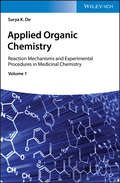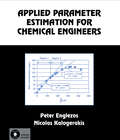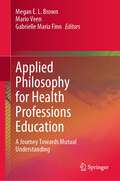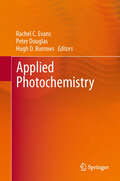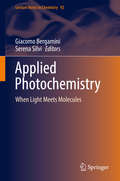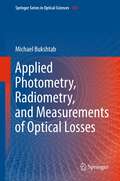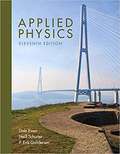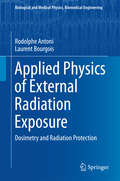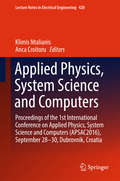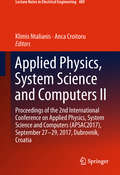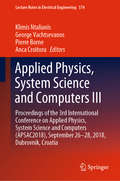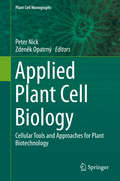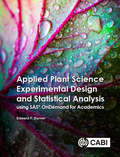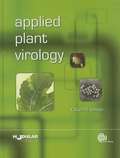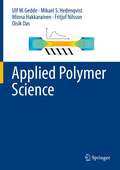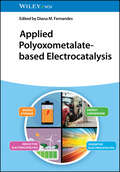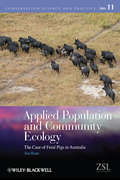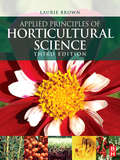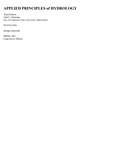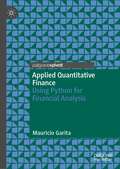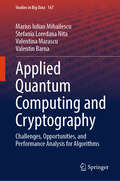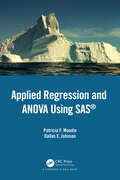- Table View
- List View
Applied Optics Fundamentals and Device Applications: Nano, MOEMS, and Biotechnology
by Mark A. MentzerHow does the field of optical engineering impact biotechnology? Perhaps for the first time, Applied Optics Fundamentals and Device Applications: Nano, MOEMS, and Biotechnology answers that question directly by integrating coverage of the many disciplines and applications involved in optical engineering, and then examining their applications in nanobiotechnology. Written by a senior U.S. Army research scientist and pioneer in the field of optical engineering, this book addresses the exponential growth in materials, applications, and cross-functional relevance of the many convergent disciplines making optical engineering possible, including nanotechnology, MEMS, (MOEMS), and biotechnology. Integrates Coverage of MOEMS, Optics, and Nanobiotechnology—and Their Market Applications Providing an unprecedented interdisciplinary perspective of optics technology, this book describes everything from core principles and fundamental relationships, to emerging technologies and practical application of devices and systems—including fiber-optic sensors, integrated and electro-optics, and specialized military applications. The author places special emphasis on: Fiber sensor systems Electro-optics and acousto-optics Optical computing and signal processing Optical device performance Thin film magnetic memory MEMS, MOEMS, nano- and bionanotechnologies Optical diagnostics and imaging Integrated optics Design constraints for materials, manufacturing, and application space Bridging the technology gaps between interrelated fields, this reference is a powerful tool for students, engineers and scientists in the electrical, chemical, mechanical, biological, aerospace, materials, and optics fields. Its value also extends to applied physicists and professionals interested in the relationships between emerging technologies and cross-disciplinary opportunities. Author Mark A. Mentzer is a pioneer in the field of optical engineering. He is a senior research scientist at the U.S. Army Research Laboratory in Maryland. Much of his current work involves extending the fields of optical engineering and solid state physics into the realm of biochemistry and molecular biology, as well as structured research in biophotonics.
Applied Organic Chemistry: Reaction Mechanisms and Experimental Procedures in Medicinal Chemistry
by Surya K. DeAn indispensable guide for all synthetic chemists who want to learn about the most relevant reactions and reagents employed to synthesize important heterocycles and drugs! The synthesis of natural products, bioactive compounds, pharmaceuticals, and drugs is of fundamental interest in modern organic chemistry. New reagents and reaction methods towards these molecules are being constantly developed. By understanding the mechanisms involved and scope and limitations of each reaction applied, organic chemists can further improve existing reaction protocols and develop novel efficient synthetic routes towards frequently used drugs, such as Aspirin or Penicillin. Applied Organic Chemistry provides a summary of important (name) reactions and reagents applied in modern organic chemistry and drug synthesis. It covers rearrangement, condensation, olefination, metathesis, aromatic electrophilic substitutions, Pd-catalyzed C-C bond forming reactions, multi-component reactions, as well as oxidations and reductions. Each chapter is clearly structured, providing valuable information on reaction details, step-by-step mechanism, experimental procedures, applications, and (patent) references. By providing mechanistic information and representative experimental procedures, this book is an indispensable guide for researchers and professionals in organic chemistry, natural product synthesis, pharmaceutical, and medicinal chemistry, as well as post-graduates preparing themselves for a job in the pharmaceutical industry. Hot Topic: Reviews important classes of organic reactions (incl. name reactions) and reagents in medicinal chemistry. Useful: Provides information on reaction details, common reagents, and functional group transformations used to synthesize natural products, bioactive compounds, drugs, and pharmaceuticals, e.g. Aspirin, Penicillin. Unique: For every reaction the mechanism is explained step by step, and representative experimental procedures are given, unlike most books in this area. User-friendly: Chapters are clearly structured making it easy for the reader to compare different reactions. Applied Organic Chemistry is an indispensable guide for researchers and professionals in organic chemistry, natural product synthesis, pharmaceutical, and medicinal chemistry, as well as post-graduates preparing themselves for a job in the pharmaceutical industry.
Applied Parameter Estimation for Chemical Engineers
by Peter Englezos Nicolas KalogerakisThis book determines adjustable parameters in mathematical models that describe steady state or dynamic systems, presenting the most important optimization methods used for parameter estimation. It focuses on the Gauss-Newton method and its modifications for systems and processes represented by algebraic or differential equation models.
Applied Philosophy for Health Professions Education: A Journey Towards Mutual Understanding
by Megan E. L. Brown Mario Veen Gabrielle Maria FinnThis book increases the accessibility of philosophical concepts to a wider audience within medical education, translating ‘knowing’ to ‘doing.’ It prompts health professions educators and researchers to consider the dynamics and structure of contemporary issues within health professions education in new, philosophical ways. Through considering the practical implications of applying philosophical concepts to contemporary issues, the book recommends avenues for further research and pedagogical change. Individual educators are considered, with practice points for teaching generated within each chapter. Readers will acquire practical ways in which they can change their own practice or pedagogy that align with the new insight offered through our philosophical analysis. These practical recommendations may be systemic in nature, but the authors of this book also offer micro-level recommendations for practitioners that can be considered as ways to improve individual approaches to education and research.
Applied Photochemistry
by Peter Douglas Hugh D. Burrow Rachel C. EvansApplied Photochemistry encompasses the major applications of the chemical effects resulting from light absorption by atoms and molecules in chemistry, physics, medicine and engineering, and contains contributions from specialists in these key areas. Particular emphasis is placed both on how photochemistry contributes to these disciplines and on what the current developments are.The book starts with a general description of the interaction between light and matter, which provides the general background to photochemistry for non-specialists. The following chapters develop the general synthetic and mechanistic aspects of photochemistry as applied to both organic and inorganic materials, together with types of materials which are useful as light absorbers, emitters, sensitisers, etc. for a wide variety of applications. A detailed discussion is presented on the photochemical processes occurring in the Earth's atmosphere, including discussion of important current aspects such as ozone depletion. Two important distinct, but interconnected, applications of photochemistry are in photocatalytic treatment of wastes and in solar energy conversion. Semiconductor photochemistry plays an important role in these and is discussed with reference to both of these areas. Free radicals and reactive oxygen species are of major importance in many chemical, biological and medical applications of photochemistry, and are discussed in depth. The following chapters discuss the relevance of using light in medicine, both with various types of phototherapy and in medical diagnostics. The development of optical sensors and probes is closely related to diagnostics, but is also relevant to many other applications, and is discussed separately. Important aspects of applied photochemistry in electronics and imaging, through processes such as photolithography, are discussed and it is shown how this is allowing the increasing miniaturisation of semiconductor devices for a wide variety of electronics applications and the development of nanometer scale devices. The final two chapters provide the basic ideas necessary to set up a photochemical laboratory and to characterise excited states. This book is aimed at those in science, engineering and medicine who are interested in applying photochemistry in a broad spectrum of areas. Each chapter has the basic theories and methods for its particular applications and directs the reader to the current, important literature in the field, making Applied Photochemistry suitable for both the novice and the experienced photochemist.
Applied Photochemistry: When Light Meets Molecules (Lecture Notes in Chemistry #92)
by Serena Silvi Giacomo BergaminiThis monograph features what happens when light meets molecules. This edited volume contains contributions from an international array of contributors, and it is divided into sections representing a selection of carefully focussed and connected photochemistry topics: energy, technology, medicine, environmental sciences, and art. In each section one or more chapters illustrates relevant aspects of each field, such as artificial photosynthesis and solar energy conversion (energy), light emitting devices and photochromic dyes (technology), and photodynamic therapy and solar filters (medicine). Aimed at students of all levels and researchers active in photochemistry.
Applied Photometry, Radiometry, and Measurements of Optical Losses (Springer Series in Optical Sciences #163)
by Michael BukshtabApplied Photometry, Radiometry, and Measurements of Optical Losses reviews and analyzes physical concepts of radiation transfer, providing quantitative foundation for the means of measurements of optical losses, which affect propagation and distribution of light waves in various media and in diverse optical systems and components. The comprehensive analysis of advanced methodologies for low-loss detection is outlined in comparison with the classic photometric and radiometric observations, having a broad range of techniques examined and summarized: from interferometric and calorimetric, resonator and polarization, phase-shift and ring-down decay, wavelength and frequency modulation to pulse separation and resonant, acousto-optic and emissive - subsequently compared to direct and balancing methods for studying free-space and polarization optics, fibers and waveguides. The material is focused on applying optical methods and procedures for evaluation of transparent, reflecting, scattering, absorbing, and aggregated objects, and for determination of power and energy parameters of radiation and color properties of light.
Applied Physics
by P. Erik Gundersen Neill Schurter Dale EwenApplied Physics, 11th Edition presents clear, to-the-point, topical coverage of basic physics applied to industrial and technical fields. Throughout the text, emphasis is placed on teaching students to use a consistent problem-solving methodology. A wealth of real-world applications are presented, motivating students by teaching physics concepts in context. Updated with new color photos, clarifications, and enhancements, the Eleventh Edition also features sections on physics-related careers and new technologies to engage readers in the material.
Applied Physics of External Radiation Exposure: Dosimetry and Radiation Protection (Biological and Medical Physics, Biomedical Engineering)
by Rodolphe Antoni Laurent BourgoisThis book describes the interaction of living matter with photons, neutrons, charged particles, electrons and ions. The authors are specialists in the field of radiation protection. The book synthesizes many years of experiments with external radiation exposure in the fields of dosimetry and radiation shielding in medical, industrial and research fields. It presents the basic physical concepts including dosimetry and offers a number of tools to be used by students, engineers and technicians to assess the radiological risk and the means to avoid them by calculating the appropriate shields. The theory of radiation interaction in matter is presented together with empirical formulas and abacus. Numerous numerical applications are treated to illustrate the different topics. The state of the art in radiation protection and dosimetry is presented in detail, especially in the field of simulation codes for external exposure to radiation, medical projects and advanced research. Moreover, important data spread in different up to date references are presented in this book. The book deals also with accelerators, X-rays facilities, sealed sources, dosimetry, Monte Carlo simulation and radiation regulation. Each chapter is split in two parts depending on the level of details the readers want to focus on. The first part, accessible to a large public, provides a lot of simple examples to help understanding the physics concepts under radiation external exposure. The second part, called "Additional Information" is not mandatory; it aims on explaining topics more deeply, often using mathematical formulations. The book treats fundamental radiometric and dosimetric quantities to describe the interaction in materials under the aspects of absorbed dose processes in tissues. Definitions and applications on limited and operational radiation protection quantities are given. An important aspect are practical engineering tools in industrial, medical and research domains. Source characterization and shielding design are addressed. Also more "exotic" topics, such as ultra intense laser and new generation accelerators, are treated. The state of the art is presented to help the reader to work with the book in a self-consistent way. The basic knowledge necessary to apply Monte Carlo methods in the field of radiation protection and dosimetry for external radiation exposure is provided. Coverage of topics such as variance reduction, pseudo-random number generation and statistic estimators make the book useful even to experienced Monte Carlo practitioners. Solved problems help the reader to understand the Monte Carlo process. The book is meant to be used by researchers, engineers and medical physicist. It is also valuable to technicians and students.
Applied Physics, System Science and Computers: Proceedings of the 1st International Conference on Applied Physics, System Science and Computers (APSAC2016), September 28-30, Dubrovnik, Croatia (Lecture Notes in Electrical Engineering #428)
by Klimis Ntalianis Anca CroitoruThis book reports on advanced theories and methods in three related fields of research: applied physics, system science and computers. It is organized in two main parts, the first of which covers applied physics topics, including lasers and accelerators; condensed matter, soft matter and materials science; nanoscience and quantum engineering; atomic, molecular, optical and plasma physics; as well as nuclear and high-energy particle physics. It also addresses astrophysics, gravitation, earth and environmental science, as well as medical and biological physics. The second part focuses on advances in system science and computers, exploring automatic circuit control, power systems, computer communication, fluid mechanics, simulation and modeling, software engineering, data structures and applications of artificial intelligence among other areas. Offering a collection of contributions presented at the 1st International Conference on Applied Physics, System Science and Computers (APSAC 2016), the book bridges the gap between applied physics and electrical engineering. It not only to presents new methods, but also promotes collaborations between different communities working on related topics at the interface between physics and engineering, with a special focus on communication, data modeling and visualization, quantum information, applied mechanics as well as bio and geophysics.
Applied Physics, System Science and Computers II: Proceedings of the 2nd International Conference on Applied Physics, System Science and Computers (APSAC2017), September 27-29, 2017, Dubrovnik, Croatia (Lecture Notes in Electrical Engineering #489)
by Klimis Ntalianis Anca CroitoruThis book reports on advanced theories and methods in three related fields of research: applied physics, system science and computers. It is organized in three parts, the first of which covers applied physics topics, including lasers and accelerators; condensed matter, soft matter and materials science; nanoscience and quantum engineering; atomic, molecular, optical and plasma physics; as well as nuclear and high-energy particle physics. It also addresses astrophysics, gravitation, earth and environmental science, as well as medical and biological physics. The second and third parts focus on advances in computers and system science, respectively, and report on automatic circuit control, power systems, computer communication, fluid mechanics, simulation and modeling, software engineering, data structures and applications of artificial intelligence among other areas. Offering a collection of contributions presented at the 2nd International Conference on Applied Physics, System Science and Computers (APSAC), held in Dubrovnik, Croatia on September 27–29, 2017, the book bridges the gap between applied physics and electrical engineering. It not only to presents new methods, but also promotes collaborations between different communities working on related topics at the interface between physics and engineering, with a special focus on communication, data modeling and visualization, quantum information, applied mechanics as well as bio and geophysics.
Applied Physics, System Science and Computers III: Proceedings of the 3rd International Conference on Applied Physics, System Science and Computers (APSAC2018), September 26-28, 2018, Dubrovnik, Croatia (Lecture Notes in Electrical Engineering #574)
by Pierre Borne Klimis Ntalianis Anca Croitoru George VachtsevanosThis book reports on advanced theories and methods in three related fields of research: applied physics, system science and computers. The first part covers applied physics topics, such as lasers and accelerators; fluid dynamics, optics and spectroscopy, among others. It also addresses astrophysics, security, and medical and biological physics. The second part focuses on advances in computers, such as those in the area of social networks, games, internet of things, deep learning models and more. The third part is especially related to systems science, covering swarm intelligence, smart cities, complexity and more. Advances in and application of computer communication, artificial intelligence, data analysis, simulation and modeling are also addressed. The book offers a collection of contributions presented at the 3nd International Conference on Applied Physics, System Science and Computers (APSAC), held in Dubrovnik, Croatia on September 26–28, 2018. Besides presenting new methods, it is also intended to promote collaborations between different communities working on related topics at the interface between physics, computer science and engineering.
Applied Plant Cell Biology: Cellular Tools and Approaches for Plant Biotechnology (Plant Cell Monographs #22)
by Peter Nick Zdeněk OpatrnyThe aim of this volume is to merge classical concepts of plant cell biology with the recent findings of molecular studies and real-world applications in a form attractive not only to specialists in the realm of fundamental research, but also to breeders and plant producers. Four sections deal with the control of development, the control of stress tolerance, the control of metabolic activity, and novel additions to the toolbox of modern plant cell biology in an exemplary and comprehensive manner and are targeted at a broad professional community. It serves as a clear example that a sustainable solution to the problems of food security must be firmly rooted in modern, continuously self re-evaluating cell-biological research. No green biotech without green cell biology. As advances in modern medicine is based on extensive knowledge of animal molecular cell biology, we need to understand the hidden laws of plant cells in order to handle crops, vegetables and forest trees. We need to exploit, not only empirically, their astounding developmental, physiological and metabolic plasticity, which allows plants to cope with environmental challenges and to restore flexible, but robust self-organisation.
Applied Plant Science Experimental Design and Statistical Analysis Using SAS® OnDemand for Academics
by Associate Profes Edward DurnerThe correct design, analysis and interpretation of plant science experiments is imperative for continued improvements in agricultural production worldwide. The enormous number of design and analysis options available for correctly implementing, analysing and interpreting research can be overwhelming. SAS® is the most widely used statistical software in the world and SAS® OnDemand for Academics is now freely available for academic institutions. This is a user-friendly guide to statistics using SAS® OnDemand for Academics, ideal for facilitating the design and analysis of plant science experiments. It presents the most frequently used statistical methods in an easy-to-follow and non-intimidating fashion, and teaches the appropriate use of SAS® within the context of plant science research. This book: - Covers experimental designs and data analysis protocols - Is presented as a how-to guide with many examples - Includes freely downloadable data sets - Examines key topics such as merging data frames, multivariate analysis and linear regression Authored by an experienced teacher of applied plant science statistics, this book assumes no prior background in statistics and guides users through the appropriate methodologies in research. It is an invaluable tool for advanced undergraduate and graduate students, in addition to researchers, extension consultants, faculty and technicians.
Applied Plant Virology
by Calum Rae WilsonWritten for advanced undergraduate students, this book is a practical, in-depth guide to plant virology. Beginning with an introduction to viruses and their classification, the text describes virus pathology, including how viruses enter and move through plant cells and induce disease. Subsequent chapters discuss how viruses spread in the field and how to measure this. Throughout, the book remains reader-friendly, using focus boxes for clear, easy to obtain information, enabling students to quickly access relevant information but supply sufficient detail for advanced studies. In addition to basic information on virus biology there is an additional focus on applied virology, ideal for students undertaking agricultural studies for whom study of disease and its control is essential.
Applied Polymer Rheology
by Marianna KontopoulouExplore polymer rheology from an industrial standpoint Presenting state-of-the-art polymer rheology as observed by well-recognized authors, Applied Polymer Rheology: Polymeric Fluids with Industrial Applications is designed to help readers understand the relationship between molecular structure and the flow behavior of polymers. In particular, it focuses on polymeric systems that elicit special attention from industry. Providing a comprehensive overview of the rheological characteristics of polymeric fluids, the book bridges the gap between theory and practice/application, enabling readers to see the connection between molecular structure and the behavior of the polymers studied. Beginning with a discussion of the properties, processability, and processing aids of specific polymers, later chapters examine filled polymers and composites, and the theoretical framework upon which their analysis is based. Various systems containing microstructure are presented subsequently, with the final chapter introducing paste extrusion of polytetrafluoroethylene paste. An invaluable reference guide that covers the literature and vast array of technical approaches to polymer rheology, Applied Polymer Rheology's coverage of polymeric fluids of interest to industry make it an essential resource for plastics, polymer, and chemical engineers, materials scientists, polymer chemists, and polymer physicists to use when interpreting findings and planning experiments.
Applied Polymer Science
by Ulf W. Gedde Mikael S. Hedenqvist Minna Hakkarainen Fritjof Nilsson Oisik DasThis companion volume to “Fundamental Polymer Science” (Gedde and Hedenqvist, 2019) offers detailed insights from leading practitioners into experimental methods, simulation and modelling, mechanical and transport properties, processing, and sustainability issues. Separate chapters are devoted to thermal analysis, microscopy, spectroscopy, scattering methods, and chromatography. Special problems and pitfalls related to the study of polymers are addressed. Careful editing for consistency and cross-referencing among the chapters, high-quality graphics, worked-out examples, and numerous references to the specialist literature make “Applied Polymer Science” an essential reference for advanced students and practicing chemists, physicists, and engineers who want to solve problems with the use of polymeric materials.
Applied Polyoxometalate-Based Electrocatalysis
by Diana M. FernandesWell-researched reference on stable alternative electrocatalysts and electrode materials with the potential to transform chemistry and processes in sensor- and energy-related technologies Applied Polyoxometalate-based Electrocatalysis delivers an overview of the variety of efficient applications of free POM and POM-based (nano)composites as exciting materials in the field of electrocatalysis. With a variety of sizes, shapes, composition, and physical and chemical properties, these composites have important properties, such as the ability to undergo reversible multivalence reductions/oxidations, leading to the formation of mixed-valence species, which brings about favorable electrocatalytic properties with regard to several electrochemical processes. Edited by a highly qualified independent researcher internationally recognized for her contributions to materials for electrochemical energy-related reactions, Applied Polyoxometalate-based Electrocatalysis includes information on: General methodologies used in the preparation of free POMs and POM-based nanocomposites and different strategies employed in electrode modification Role of POM-modified electrodes in oxidative and reductive electrocatalysis, including the detection/sensing of several (bio)molecules of interest and carbon dioxide electroreduction Application of POM-based (nano)composites, including the oxygen reduction reaction relevant to fuel cells, the oxygen and hydrogen evolution reactions, and batteries and supercapacitors Applied Polyoxometalate-based Electrocatalysis is an essential reference on the subject for chemists, material scientists, chemical engineers, and institutions involved in work related to free POM and POM-based (nano)composites.
Applied Population and Community Ecology: The Case of Feral Pigs in Australia (Conservation Science and Practice)
by Jim HonePart of the Zoological Society of London's Conservation Science and Practice Series, Applied Population and Community Ecology evaluates theory in population and community ecology using a case study of feral pigs, birds and plants in the high country of south-eastern Australia. In sequence, the book reviews the relevant theory and uses long-term research over a quarter of a century on the population ecology of feral pigs and then community ecology of birds and plants, to evaluate the theory. The book brings together into one volume, research results of many observational, experimental and modelling studies and directly compares them with those from related studies around the world. The implications of the results for future wildlife management are also discussed. Intended readers are ecologists, graduate students in ecology and wildlife management and conservation and pest managers.
Applied Principles of Horticultural Science
by Laurie BrownApplied Principles of Horticultural Science is that critical thing for all students of horticulture - a book that teaches the theory of horticultural science through the practice of horticulture itelf.The book is divided into three sections - Plant science, Soil science, Pest and disease. Each section contains a number of chapters relating to a major principle of applied horticulture. Each chapter starts with a key point summary and introduces the underpinning knowledge which is then reinforced by exercises. The book contains over 70 practical exercises, presented in a way that makes students think for themselves. Answers to the exercises are given at the end of chapters. Clear step-by-step instructions make practical work accessible to students of all abilities.This new third edition provides an even wider sweep of case studies to make this book an essential practical workbook for horticulture students and gardners alike. Updated material fits with the latest RHS, City and Guilds and Edexcel syllabus. It is particularly suitable for the RHS Certificate, Advanced Certificate and Edexcel Diplomas as well as for those undertaking NPTC National, Advanced National courses and Horticulture NVQs at levels 2 and 3, together with the new Diploma in Environmental and Land-based studies.Laurie Brown is a horticultural scientist and educator. He is Director of Academex, a consultancy company aspiring to excellence in teaching and learning. Laurie previously worked with the Standards Unit on the design of exemplary teaching resources in the land-based sector.
Applied Principles Of Hydrology
by John C. ManningLess than 1% of the Earth's water is available for human use, the average family uses 400 gallons of water daily, and expected population growth means an increase in water use. The study of hydrology how water behaves as it moves through the water cycle is vital to reducing strains on our water supply and infrastructure.
Applied Quantitative Finance: Using Python for Financial Analysis
by Mauricio GaritaThis book provides both conceptual knowledge of quantitative finance and a hands-on approach to using Python. It begins with a description of concepts prior to the application of Python with the purpose of understanding how to compute and interpret results. This book offers practical applications in the field of finance concerning Python, a language that is more and more relevant in the financial arena due to big data. This will lead to a better understanding of finance as it gives a descriptive process for students, academics and practitioners.
Applied Quantum Computing and Cryptography: Challenges, Opportunities, and Performance Analysis for Algorithms (Studies in Big Data #167)
by Marius Iulian Mihailescu Stefania Loredana Nita Valentina Marascu Valentin BarnaThis book explores the dynamically developing areas of quantum computing and quantum cryptography. The book offers an in-depth examination of the possibilities and difficulties presented by these revolutionary technologies, with the goal of connecting abstract ideas with real-world applications. The book is an extremely helpful resource in the context of the upcoming quantum age. This highlights the importance of creating cryptographic techniques that can withstand the power of quantum computers to protect digital communications and vital infrastructures. This work makes a substantial contribution to the topic of cybersecurity by doing a comprehensive analysis of classical and quantum cryptography approaches, as well as actual implementations and performance evaluations. The book plays a vital role in providing valuable guidance to researchers, practitioners, and policymakers. It offers valuable insights that are necessary for effectively managing the shift towards quantum-secure technology and safeguarding the future security of digital information.
Applied Regression and ANOVA Using SAS
by Patricia F. Moodie Dallas E. JohnsonApplied Regression and ANOVA Using SAS® has been written specifically for non-statisticians and applied statisticians who are primarily interested in what their data are revealing. Interpretation of results are key throughout this intermediate-level applied statistics book. The authors introduce each method by discussing its characteristic features, reasons for its use, and its underlying assumptions. They then guide readers in applying each method by suggesting a step-by-step approach while providing annotated SAS programs to implement these steps.Those unfamiliar with SAS software will find this book helpful as SAS programming basics are covered in the first chapter. Subsequent chapters give programming details on a need-to-know basis. Experienced as well as entry-level SAS users will find the book useful in applying linear regression and ANOVA methods, as explanations of SAS statements and options chosen for specific methods are provided.Features:•Statistical concepts presented in words without matrix algebra and calculus•Numerous SAS programs, including examples which require minimum programming effort to produce high resolution publication-ready graphics•Practical advice on interpreting results in light of relatively recent views on threshold p-values, multiple testing, simultaneous confidence intervals, confounding adjustment, bootstrapping, and predictor variable selection•Suggestions of alternative approaches when a method’s ideal inference conditions are unreasonable for one’s dataThis book is invaluable for non-statisticians and applied statisticians who analyze and interpret real-world data. It could be used in a graduate level course for non-statistical disciplines as well as in an applied undergraduate course in statistics or biostatistics.
Applied Research Methods in Urban and Regional Planning
by Yanmei Li Sumei ZhangThis book introduces the fundamentals of research methods and how they apply to the discipline of urban and regional planning. Written at a level appropriate for upper-level undergraduate and beginning master’s level students, the text fills a gap in the literature for textbooks on urban planning. Additionally, the book can be used as a reference for planning practitioners and researchers when analyzing quantitative and qualitative data in urban and regional planning and related fields.The volume does not assume advanced knowledge of mathematical formulas. Rather, it begins with the essentials of research methods, such as the identification of the research problems in planning, the literature review, data collection and presentation, descriptive data analysis, and report of findings. Its discipline-specific topics include field research methods, qualitative data analysis, economic and demographic analysis, evaluation research, and methods in sub-disciplines such as land use planning, transportation planning, environmental planning, and housing analysis. Designed with instruction in mind, this book features downloadable materials, including learning outcomes, chapter highlights, chapter review questions, datasets, and certain Excel models. Students will be able to download review questions to enhance the learning process and datasets to practice methods.

